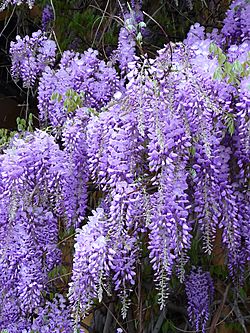Wisteria facts for kids
Quick facts for kids Wisteria |
|
|---|---|
 |
|
| Flowering Wisteria sinensis | |
| Scientific classification | |
| Kingdom: | |
| (unranked): | |
| (unranked): | |
| (unranked): | |
| Order: | |
| Family: | |
| Subfamily: | |
| Tribe: |
Millettieae
|
| Genus: |
Wisteria
Nutt.
|
Wisteria is a beautiful type of plant known for its amazing flowers. It is a climbing shrub, which means it grows upwards by wrapping around things like fences, walls, or trees. Wisteria plants are famous for their lovely blue or lilac-colored flowers.
These plants don't flower right away; they usually need to grow for a few years first. But when they do bloom, their flowers have a very sweet smell that fills the air. Wisteria plants lose their leaves in the winter, like many other trees and shrubs. After the flowers fade, the plant produces seeds inside pods, and these seeds are shaped like small discs.
Contents
What is Wisteria?
Wisteria is a genus, or group, of about 10 different types of flowering plants. They are part of the pea family, called Fabaceae. Most Wisteria plants are native to China, Korea, Japan, and the eastern United States. They are very popular in gardens around the world because of their stunning flowers and climbing habit.
How Does Wisteria Grow?
Wisteria plants are strong climbers. They use their stems to twist around supports, growing taller and wider each year. Some Wisteria plants can grow very large, covering entire walls or pergolas. They need strong support because they can become quite heavy as they mature.
When Does Wisteria Bloom?
Wisteria usually blooms in the spring, often before its leaves fully appear. This makes the flowers even more noticeable. The flowers hang down in long bunches, called racemes, which can be quite impressive. The exact time of blooming depends on the specific type of Wisteria and the local climate.
Are Wisteria Plants Safe?
It's important to know that all parts of the Wisteria plant, especially its seeds, contain substances that can be harmful if eaten. These substances are called wisterin toxins. Because of this, it's best to admire Wisteria flowers from a distance and never try to eat any part of the plant. If you have Wisteria in your garden, it's a good idea to teach younger children not to put any plant parts in their mouths.
Images for kids
See also
 In Spanish: Glicina para niños
In Spanish: Glicina para niños


